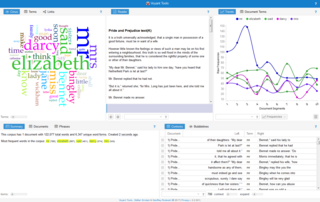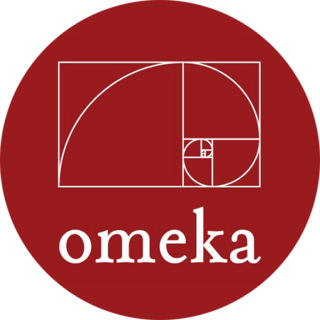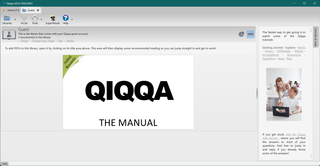The Graduate School and University Center of the City University of New York is a public research institution and postgraduate university in New York City. Serving as the principal doctorate-granting institution of the City University of New York (CUNY) system, The CUNY Graduate Center is classified among "R1: Doctoral Universities – Very High Research Activity". The school is located at the B. Altman and Company Building at 365 Fifth Avenue in Midtown Manhattan. The CUNY Graduate Center offers 31 doctoral programs, 14 master's programs, and 30 research centers and institutes. It employs a core faculty of approximately 140, who are supplemented by 1,800 faculty members from CUNY's eleven senior colleges and New York City's cultural and scientific institutions. As of June 2024, the Graduate Center enrolls 3,228 students, of which 2,621 or 81% are doctoral students.
An application program is a computer program designed to carry out a specific task other than one relating to the operation of the computer itself, typically to be used by end-users. Word processors, media players, and accounting software are examples. The collective noun "application software" refers to all applications collectively. The other principal classifications of software are system software, relating to the operation of the computer, and utility software ("utilities").
Reference management software, citation management software, or bibliographic management software is software that stores a database of bibliographic records and produces bibliographic citations (references) for those records, needed in scholarly research. Once a record has been stored, it can be used time and again in generating bibliographies, such as lists of references in scholarly books and articles. Modern reference management applications can usually be integrated with word processors so that a reference list in one of the many different bibliographic formats required by publishers and scholarly journals is produced automatically as an article is written, reducing the risk that a cited source is not included in the reference list. They will also have a facility for importing bibliographic records from bibliographic databases.

DSpace is an open source repository software package typically used for creating open access repositories for scholarly and/or published digital content. While DSpace shares some feature overlap with content management systems and document management systems, the DSpace repository software serves a specific need as a digital archives system, focused on the long-term storage, access and preservation of digital content. The optional DSpace registry lists almost three thousand repositories all over the world.
Roy Rosenzweig Center for History and New Media (RRCHNM), formerly the Center for History and New Media (CHNM), is a research center specializing in digital history and information technology at George Mason University (GMU) in Fairfax County, Virginia. It was one of the first digital history centers in the world, established by Roy Rosenzweig in 1994 to use digital media and information technology to democratize history: to incorporate multiple voices, reach diverse audiences, and encourage popular participation in presenting and preserving the past. Its current director is Lincoln Mullen.

Digital humanities (DH) is an area of scholarly activity at the intersection of computing or digital technologies and the disciplines of the humanities. It includes the systematic use of digital resources in the humanities, as well as the analysis of their application. DH can be defined as new ways of doing scholarship that involve collaborative, transdisciplinary, and computationally engaged research, teaching, and publishing. It brings digital tools and methods to the study of the humanities with the recognition that the printed word is no longer the main medium for knowledge production and distribution.
EndNote is a commercial reference management software package, used to manage bibliographies and references when writing essays, reports and articles. EndNote was written by Richard Niles, and ownership changed hands several times since it was launched in 1989 by Niles & Associates: in 2000 it was acquired by Institute for Scientific Information’s ResearchSoft Division, part of Thomson Corporation, and in 2016 by Clarivate. EndNote's main competitors are Mendeley and Zotero. Unlike Mendeley and Zotero, EndNote is neither free-to-use nor offers a freemium model.

Zotero is free and open-source reference management software to manage bibliographic data and related research materials, such as PDF and ePUB files. Features include web browser integration, online syncing, generation of in-text citations, footnotes, and bibliographies, integrated PDF, ePUB and HTML readers with annotation capabilities, and a note editor, as well as integration with the word processors Microsoft Word, LibreOffice Writer, and Google Docs. It was originally created at the Center for History and New Media at George Mason University and, as of 2021, is developed by the non-profit Corporation for Digital Scholarship.

Roy Alan Rosenzweig was an American historian. He was the founder and director of the Center for History and New Media at George Mason University from 1994 until his death in October 2007 from lung cancer, aged 57. After his death, the center was renamed the Roy Rosenzweig Center for History and New Media in his honor.
The following tables compare notable reference management software. The comparison includes older applications that may no longer be supported, as well as actively-maintained software.
Digital history is the use of digital media to further historical analysis, presentation, and research. It is a branch of the digital humanities and an extension of quantitative history, cliometrics, and computing. Digital history is commonly digital public history, concerned primarily with engaging online audiences with historical content, or, digital research methods, that further academic research. Digital history outputs include: digital archives, online presentations, data visualizations, interactive maps, timelines, audio files, and virtual worlds to make history more accessible to the user. Recent digital history projects focus on creativity, collaboration, and technical innovation, text mining, corpus linguistics, network analysis, 3D modeling, and big data analysis. By utilizing these resources, the user can rapidly develop new analyses that can link to, extend, and bring to life existing histories.

Omeka is a free, open-source content management system for online digital collections. As a web application, it allows users to publish and exhibit cultural heritage objects, and extend its functionality with themes and plugins. A lightweight solution in comparison to traditional institutional repository software like DSpace and Fedora, Omeka has a focus on display and uses an unqualified Dublin Core metadata standard.
Teachinghistory.org, also known as the National History Education Clearinghouse (NHEC), is a website that provides educational resources for the study of U.S. history.

Joshua "Josh" M. Greenberg is an American academic working in sociology of scientific knowledge. Greenberg is Program Director for Digital Information Technology at the Alfred P. Sloan Foundation. Previously he was the Director of Digital Strategy and Scholarship at the New York Public Library (NYPL). His interests encompass the intersection of scholarship, education and information technology. His initiatives at NYPL engaged the nascent disciplines of digital asset management.

Qiqqa is a free and open-source software that allows researchers to work with thousands of PDFs. It combines PDF reference management tools, a citation manager, and a mind map brainstorming tool. It integrates with Microsoft Word XP, 2003, 2007 and 2010 and BibTeX/LaTeX to automatically produce citations and bibliographies in thousands of styles.
The CUNY Academic Commons is an online, academic social network for community members of the City University of New York (CUNY) system. Designed to foster conversation, collaboration, and connections among the 24 individual colleges that make up the university system, the site, founded in 2009, has quickly grown as a hub for the CUNY community, serving in the process to strengthen a growing group of digital scholars, teachers, and open-source projects at the university.

University of Cape Town Libraries is the library system of the University of Cape Town in Cape Town, South Africa.

Samvera, originally known as Hydra, is an open-source digital repository software product. Samvera main components are Fedora Commons, Solr, Blacklight, and HydraHead. Each Samvera implementation is called a "head".

Tropy is a free and open-source desktop knowledge organization application that helps users manage and describe photographs of research materials. It was developed by the Center for History and New Media at George Mason University. Photos imported into Tropy can be combined into single items, described with metadata that is applied in bulk or created with custom metadata templates, annotated with research notes, and tagged in accordance with a researcher's preferred mode of organization.








